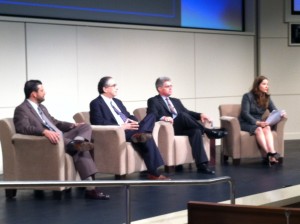
Today's second annual SAS Financial Services Executive Summit included a great panel discussion moderated by Lori Bieda from SAS, and featuring Greg Holzwarth, SVP and Managing Director, Customer Information Management at SunTrust Bank, Harvey Koeppel, former CIO and SVP of the Global Consumer Group at Citigroup, and Joseph Grillo, VP of Direct Marketing, Global Accident and Health at ACE Group.
The panel explored how they have used analytics to better understand their customers in today's digital world. Along the way, they touched on key topics critical financial services industry marketing, such as the need to focus on customer experience and challenges in getting complete customer profiles considering the veritable explosion of big data.
In terms of customer experience, Greg offered that SunTrust seized the opportunity to focus on customer experience during the most recent financial crisis by building their own loyalty model, called Live Solid / Bank Solid. They based the program on what they know about their own customers, as opposed to using a generic industry model, and they centered the program on customer experiences, and based it all on analytics.
Harvey described the approach they took at Citibank when they merged with Traveler’s in 1999 to become Citigroup. The consumer group was then a $14B business, servicing 150 million customers in 54 countries around the world. Identifying customer experience across all channels was recognized as being fundamentally important, so their strategy was based on both experiential data and behavioral data that informed next best conversations. As the different bank operating units had interactions with the customer, they updated profiles in real-time and then shared the data across all channels.
Joe brought an interesting perspective from the insurance industry, and he said that the largest insurers are all comparable in terms of analytic capabilities, but how they differentiate themselves is in terms of the implementation.
Our digital world and the advent of social media have clearly changed the rules for customer valuation and customer interactions. Harvey described how the approach at Citi was focused on the conversation and maximizing the value for the customer. As a global bank serving global customers, they knew they should take steps to be sure for instance that a New York customer could walk into a branch in London and be treated as if they were dealing with their home branch in the big apple. Not an easy task, but certainly enabled by technology.
As they looked to the future, these industry leaders considered the impact of both social and mobile on the expectations that customers have, and the necessary changes to meet those expectations. Harvey cited location-based services and how they would play a big role in real-time customer interactions in banking, with possibilities such as competitive geo-fencing so mobile customers receive your offers when they check in at one of your competitors.
One thought raised is a recurring theme recently on this blog, which is the idea that all marketers today have to balance how they use social media data and customer data with avoiding being creepy. It's interesting how everyone can relate to the bad feeling they might get when they realize they're being stalked or followed, so it will be interesting to see if consensus develops over time regarding the limits of creepiness or if limits will change over time once the use of customer analytics becomes more universally apparent.
The discussion ended with the idea that big data is unavoidable when considering the role of analytics and social media in helping marketers know their customers . Harvey noted that the amount of video content uploaded to YouTube in any given week is more content than was produced by TV and movies for the entire history of analog video recording.
Considering all these possibilities and constraints, it seems the question, "How well do you know your customer?"may not always be an easy one to answer with certainty, but considering ever-changing customer expectations and empowerment, it's a question worth asking over and over again.
